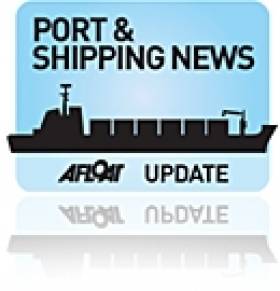Displaying items by tag: Arklow's Latest Launch
Arklow’s Final ‘Green’ Newbuild Makes A Splash!
#ArklowsLastestLaunch – Arklow Breeze had the honour of been launched as the newest and final newbuild of six cargoships from a Dutch yard last Friday, writes Jehan Ashmore.
The ceremony for Yard No. (Nb) 414 saw a successfull sideways launch at the Westerbroek yard of Ferus Smit. The same Dutch yard having completed all of the previous bulk oriented general cargoships of 8,660dwt for Arklow Shipping. She joins the company's Dutch division based in Rotterdam, Arklow Shipping Netherland N.V.
A 119m long hull form without a bulb-less bow design has given the series 'green' credentials. This is to improve operating efficiency by reducing wave resistance in varying sea-state conditions without compromising on cargo-loads.
The bulb-less concept, instead features a straight-stemmed bow to allow a slender hull entry to slice into the waves. While at the same time taking into account various loading drafts. Total performance of this bow design will also be better than that of a bulb optimised for one single-draft and flat water only conditions.
Almost a year ago, Arklow Bay was also given a spectacular launch, see VIDEO. As for Arklow Breeze she is due to enter service next month.
She follows Arklow Brave which called to Dublin Port this month and whose agents are the Burke Shipping Group which invested in new port infrastructure late last year.
The new cargoship had loaded scrap metal elsewhere in the port alongside the Hammond Lane Metal Company. She departed laden with the cargo bound for Leixoes in Portugal.
The sisters will be mainly employed in the shipment of wheat, corn and other bulk commodities in European waters.






























































